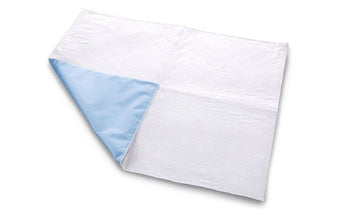 |
Bedsores
|
Common Bedsore Locations
|
|
Bedsores, also called decubitus ulcers, are areas of damaged skin tissue which can cause severe infections, some of which are life-threatening. You are at risk as a result if your skin is exposed to moisture and any combination of prolonged pressure, shear, friction and heat. Your risk increases if you use a wheelchair, are bedridden, or are unable to change your position. Bedsores commonly form on the heels, ankles, buttocks, hips, back and elbows. Immediately contact your doctor if you show signs of infection, such as increased redness or swelling around a skin ulcer, a fever, drainage from an open sore, or if you detect an odor. Causes Friction: occurs when the skin rubs against clothing or bedding. It can make fragile skin more vulnerable to injury. Sheets Protect the Skin
|
Watch DermaTherapy
••• "Consider using silk-like fabrics rather than cotton or cotton-blend fabrics to reduce shear and friction." •••

|
|
Regulating Moisture and Heat DermaTherapy®'s uniquely engineered fibers have micro channels that wicks moisture away 
|
 |
|
Cost: Prevention is always better than a cure. The average cost of treating a pressure ulcer is estimated at ~$10k. DermaTherapy sheets are relatively inexpensive compared to other interventions. In addition DermaTherapy sheets deliver lasting protection for years. Other Causes Prevention |
Products
|
Clinically-Proven Technology for Bedsores
DermaTherapy bedding was compared with standard hospital bedding for 307 patients at risk of pressure wound development in an acute-care renal unit, over a six-month period.1
62%Fewer SoresWere Developed |
90%More SoresWere Resolved |
40%Fewer SoresAt Discharge |
11%Fewer DaysIn The Hospital |
Tips For Skin Care
Inspect the skin daily and look carefully for warning signs of a bedsore. Keep skin clean and dry. Use a gentle cleanser to wash the skin and pat, not rub, dry. Repeat this cleansing routine regularly to reduce the skin's exposure to moisture, stool and urine. Protect the skin from friction and shear. DermaTherapy includes design elements that protect against the causes of friction and shear.
Symptoms Of Bedsores
According to the National Pressure Ulcer Advisory Panel, there are 4 stages of bedsores:
Stage 1: Skin looks red and can feel warm to the touch. You may also experience pain or itch. With darkly pigmented skin, the bedsore may have a blue or purple tint.
Stage 2: Affected skin shows more damaged and is very painful. The wound bed is visible, pink or red, moist and may also present as an intact or ruptured blister.
Stage 3: At this stage, bedsores are deeper and usually have a crater-like appearance.
Stage 4: This is the most severe type of bedsore. Patients will have a significant gaping wound with exposed muscle, tendons and bone which is very susceptible to infection.
Complications
Complications of bedsores, some of which are life-threatening, include:
Cellulitis: Cellulitis is an infection of the skin and adjacent soft tissues. Symptoms can be warmth, redness and swelling of the affected area.
Bone and joint infections: An infection from a bedsore can invade into bones and joints. Joint infections (septic arthritis) can damage cartilage. Bone infections (osteomyelitis) can limit the function of the limbs.
Cancer: Marjolin's ulcers (long-term, non-healing wounds) can develop into a type of squamous cell carcinoma
Sepsis: An untreated pressure injury can often lead to sepsis.
 |
"The fabric is designed to reduce friction, which allows a patient to move easily across the bed, making it less likely that a patient’s weakened or moist skin could develop a pressure ulcer or bedsore." - Annette Smith, VP of Nursing and Patient Services, Wesley Long Hospital |
Shop Collection
Food and Drug Administration (FDA)
DermaTherapy has FDA clearance as a Class I medical device for atopic dermatitis, eczema and psoriasis, and pressure sores. DermaTherapy is the first and only bedding to achieve this distinction. Technical classifications for DermaTherapy include:
Class I medical device for use by patients who are susceptible to pressure ulcers. DermaTherapy Bed Linens help to reduce the likelihood of patients developing pressure ulcers by reducing moisture, friction and shear on the patient’s skin. (Reg. K152884)
Developing pressure ulcers (also known as bedsores) is inevitable when you’re confined to bed for long periods of time. Cotton-blend sheets collect moisture that increases friction and creates an adverse microclimate around the body, leading to painful beds sores. Our anti-microbial sheets wick away the moisture that accumulates between the patient and the mattress, creating a favorable and protective microclimate. Infections never see the light of day, and bedsores can heal in these conditions. In fact, people develop 62% fewer bedsores when using DermaTherapy linens.
 |
Dermatherapy Is Providing Great Relief To Those Living With Disabilities “I am able to sleep comfortably and stay dry in my bed. I can sleep friction free thanks to DermaTherapy bedding.” ● “The sweating has stopped and I can sleep comfortably!” ● “I am able to transfer and shift in the bed without the shearing damage to my skin and the sheets have a smoothness to them that makes them comfortable and cool.” ● “Very impressed at how kind they are to my skin.” ● “I like the ability to get up and slide and maneuver myself out of bed!” ● “It has helped me with my sleeping and turning over. I would recommend it to people with disability.“ ● “I overall like it, and Yes I would recommend them to anyone. They are great!” Source: Feedback received from a three-month evaluation of DermaTherapy with the Richmond Paralyzed Veterans of America |
| Products are 100% Guaranteed |
DermaTherapy® also provides relief from other conditions:
1 Coladonato J, Smith A, Watson N, Brown AT, McNichol LL, Clegg A, McPhail L, Griffin T, Montgomery TG. Prospective, Nonrandomized Controlled Trials to Compare the Effect of a Silk-Like Fabric to Standard Hospital Linens on the Rate of Hospital-acquired Pressure Ulcers. J Ostomy Wound Management 2012; 58(10):14-31.










